Research News
-
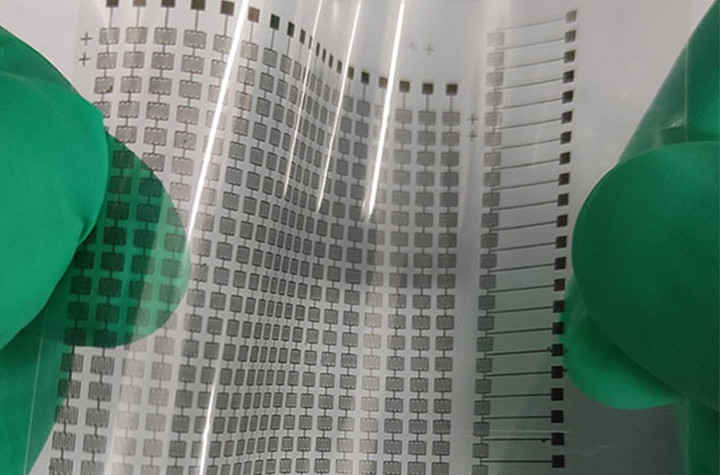 12 01, 2022Researchers Develop Novel Monolithic Integrated Micro-supercapacitorsResearchers has developed monolithic integrated micro-supercapacitors with ultrahigh systemic volumetric performance and areal output
12 01, 2022Researchers Develop Novel Monolithic Integrated Micro-supercapacitorsResearchers has developed monolithic integrated micro-supercapacitors with ultrahigh systemic volumetric performance and areal output
Microscale electrochemical energy storage systems with high systemic performance, superior cell number density, tunable capacitance, and output voltage are promising for miniaturized electronics.
A joint research team led by Prof. WU Zhong-Shuai and Prof. LU Yao from the Dalian institute of chemical physics (DICP) of the Chinese Academy of Sciences (CAS), in collaboration with Prof. CHENG Huiming's group from Shenzhen Institute of Advanced Technology and the Institute of Metal Research of CAS, has developed monolithic integrated micro-supercapacitors with ultrahigh systemic volumetric performance and areal output voltages.
This study was published in National Science Review on Nov. 26.
The fabrication and electrochemical characterization of M-MIMSCs (Image by WANG Sen and LI Linmei)
On-chip interdigitated micro-supercapacitors (MSCs), free of separators and external metal connection wires and simultaneously with reliable electrochemical performance and tunable connection, can boost cell number density and systemic performance for monolithic integrated MSCs (MIMSCs) with desirable customizability in a limited space.
However, scalable production of fully-functioning compact MIMSCs with high systemic performance, superior cell number density and tunable performance is still challenging. This is due to the difficulty of precise deposition of electrolytes on densely-packed MSCs for electrochemical isolation, sacrifice in electrochemical performance during complex microfabrication procedures, and limited performance uniformity among numerous individual cells in large scale arrays.
In this study, the researchers developed a universal and large-throughput microfabrication strategy to address the above issues by combining multi-step lithographic patterning, spray printing of MXene microelectrodes, and controllable three-dimensional (3D) printing of gel electrolytes.
They fabricated the monolithic integration of electrochemically isolated micro-supercapacitors in closely proximity by leveraging high-resolution micropatterning techniques for microelectrode deposition and 3D printing for precise electrolyte deposition.
They obtained the MIMSCs with a high areal number density of 28 cells cm-2 (400 cells on 3.5×4.1 cm2), a record areal output voltage of 75.6 V cm-2, an acceptable systemic volumetric energy density of 9.8 mWh cm-3, and a high-capacitance retention of 92 % after 4,000 cycles at the output voltage of 162 V.
"This work paves the way for monolithic integrated and microscopic energy storage assemblies for powering future microelectronics," said Prof. WU.
This work was supported by the National Natural Science Foundation of China, the Strategic Priority Research Program of CAS, Dalian Innovation Support Plan for High Level Talents, and the China Postdoctoral Science Foundation. (Text by WANG Sen and LI Linmei) -
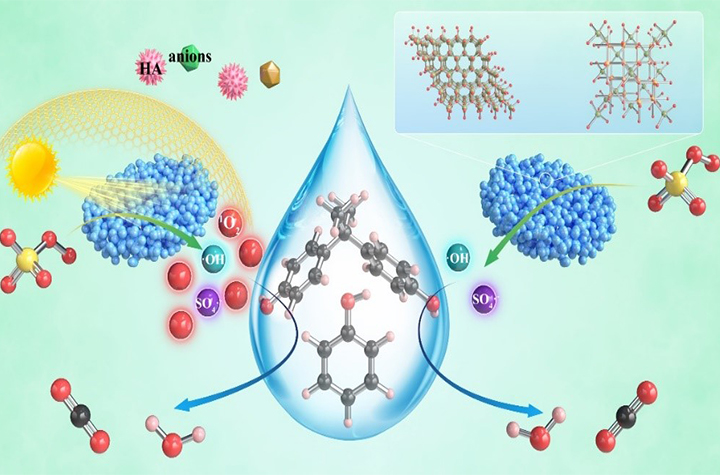 11 28, 2022New Strategy to Modulate Reaction Pathway of Zn-Fe Double Oxide Fenton Catalyst by Visible Light IrradiationResearchers achieved the effective regulation of the reaction pathway of zinc-iron double oxide Fenton-like catalyst through visible light irradiation, providing a new strategy for the modulation of mechanism from radical to non-radical of heterogeneous catalyst in Fenton-like reaction.
11 28, 2022New Strategy to Modulate Reaction Pathway of Zn-Fe Double Oxide Fenton Catalyst by Visible Light IrradiationResearchers achieved the effective regulation of the reaction pathway of zinc-iron double oxide Fenton-like catalyst through visible light irradiation, providing a new strategy for the modulation of mechanism from radical to non-radical of heterogeneous catalyst in Fenton-like reaction.
A research group led by Prof. WANG Junhu from the Dalian institute of chemical physics (DICP) of the Chinese Academy of Sciences (CAS) has proposed a new strategy to effectively regulate the reaction pathway of zinc-iron double oxide Fenton-like catalyst through visible light irradiation, which can help to modulate the mechanism from radical to non-radical of heterogeneous catalyst in Fenton-like reaction.
The study was published in Chemical Engineering Journal on Nov. 8.
Possible mechanisms of organic pollutant degradation in ZFO-4/PMS/vis system (left) and ZFO-4/PMS system (Image by ZHANG Liang)
The quenching of radical groups in Fenton-like reactions by various inorganic anions or high concentration of organic matter limits their value in industrial applications.
Non-radical-dominated systems can effectively overcome the above limitations, showing high activity against the degradation of contaminants under widespread matrix interference in water.
In this study, the researchers prepared a series of Zn-Fe double oxides by calcining the Zn1-xFex-Fe Prussian blue analogues in an ambient atmosphere. They revealed that the samples ZFO-1 and -4 were composed of nanocomposited ZnFe2O4 and ZnO, while ZFO-2 and -3 were consisted of ZnFe2O4 and Fe2O3.
Under the conditions of visible light irradiation and peroxonosulfate (PMS) Zn-Fe double oxides showed good catalytic performance for the oxidation of various organic pollutants with the leaching of trace iron, and superior pollutant decomposition efficiency in high concentration organic matter humic acid, varous kinds of anions and simulated actual water system. This suggested that visible light plays an important role in the PMS-based Fenton-like reaction over Zn-Fe double oxides.
Through radical quenching experiments and EPR spectroscopy characterization, photoinduced electrons and holes could be employed to trigger the efficient activation of PMS, thus transforming the reaction pathway in the prepared Zn-Fe dioxides from the radical pathway to the non-radical pathway dominated by singlet oxygen (1O2).
"This work provides a new perspective for using solar energy to regulate radical and non-radical pathways in advanced PMS-based oxidation processes," said Prof. WANG.
The above work was supported by the National Natural Science Foundation of China, and the International Partnership Program of CAS. (Text by ZHANG Liang) -
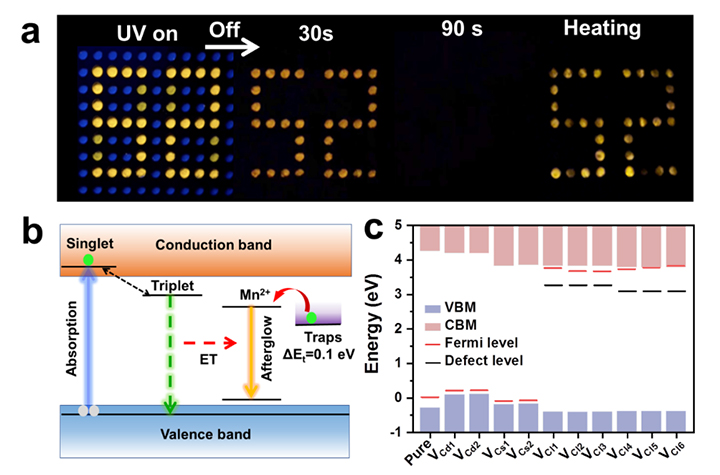 11 23, 2022Researchers Develop High-Efficiency Afterglow MaterialResearchers has developed cadmium (Cd)-based perovskite single crystals with long afterglow and high luminous quantum yield, and investigated its afterglow luminescence dynamics mechanism.
11 23, 2022Researchers Develop High-Efficiency Afterglow MaterialResearchers has developed cadmium (Cd)-based perovskite single crystals with long afterglow and high luminous quantum yield, and investigated its afterglow luminescence dynamics mechanism.
Dr. YANG Bin and his coworkers from the Dalian Institute of Chemical Physics (DICP) of the Chinese Academy of Sciences (CAS) has developed cadmium (Cd)-based perovskite single crystals with long afterglow and high luminous quantum yield, and investigated its afterglow luminescence dynamics mechanism.
The study was published in Angewandte Chemie International Edition on Oct. 21.
Afterglow materials have the ability to store multiple radiations such as visible photons, ultraviolet rays, and X-rays. They are widely used in display, biological imaging, anti-counterfeiting technology, and data storage.
However, traditional all-inorganic phosphors, such as oxide, sulfide, and nitride-based afterglow materials, have high lattice energies and usually need to be produced by high-temperature processing (>1000°C), which brings considerable energy consumption and safety risks to production and preparation.
Using solution-processed perovskite CsCdCl3 single crystal as the afterglow matrix, the researchers proposed a luminescence strategy based on energy transfer from triplet self-trapped excitons (STE) to the acceptor Mn+ through Mn2+ doping. They developed a high-efficiency ultra-long anti-thermal quenching afterglow emitting phosphor, which could simultaneously achieve high luminescence quantum yield (81.5%) and ultra-long afterglow time (150 seconds).
Moreover, they provided clear evidence for the luminescence mechanism through in-depth carrier dynamics studies and density functional theory (DFT) calculations. They found that the CsCdCl3:Mn2+ structure had [CdCl6]4- octahedron with plane symmetry (C3v symmetry) and angular symmetry (D3d symmetry) nature, which could form inequivalent Cl vacancies, and result in trap states with a broad energy distribution.
"We found that these trap states can store charge carriers and slowly release them to the emission center ([MnCl6]4- octahedron), resulting in afterglow emission with anti-thermal quenching effect," said Dr. YANG.
The work was supported by the National Natural Science Foundation of China, the Youth Promotion Association of CAS, and the Innovation Funding of DICP. (Text by TANG Zhe) -
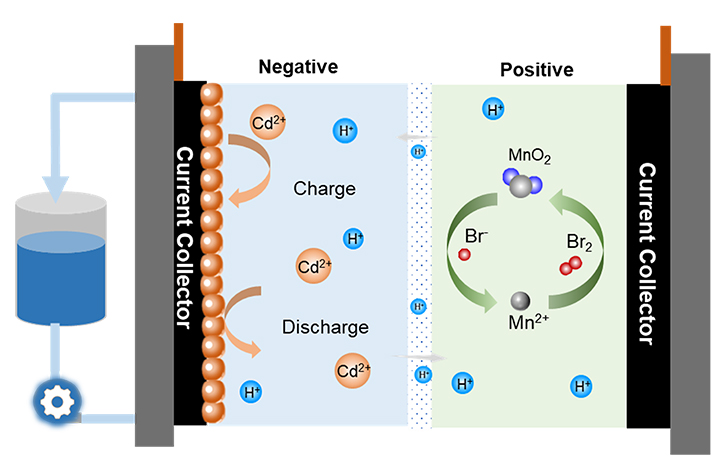 11 21, 2022Scientists Develop Manganese-based Hybrid Single Flow Battery with High Energy DensityResearchers proposed a hybrid flow battery based on Bromine Assisted MnO2 Dissolution Chemistry, which exhibits the advantages of high energy density and reversibility.
11 21, 2022Scientists Develop Manganese-based Hybrid Single Flow Battery with High Energy DensityResearchers proposed a hybrid flow battery based on Bromine Assisted MnO2 Dissolution Chemistry, which exhibits the advantages of high energy density and reversibility.
A research group led by Prof. LI Xianfeng from the Dalian Institute of Chemical Physics (DICP) of the Chinese Academy of Sciences (CAS) has developed a Bromine-assisted-MnO2-based hybrid single flow battery, which exhibits advantages of high energy density and reversibility.
This study was published in Angewandte Chemie International Edition on Oct. 26.
Mn2+/Mn3+ redox pair has been considered as a promising cathode for high-energy-density batteries, due to its attractive features of high redox potential, solubility and outstanding kinetics. However, the disproportionation side reaction of Mn3+, which results in accumulation of "dead" MnO2, limits its reversibility and further energy density.
In this study, the researchers provided a new concept to solve the issue of "dead" MnO2 by introducing Br-/Br2 into Mn2+/MnO2 catholyte in a highly acidic environment.
Br- was firstly oxidized to Br2 during charge, and then Mn2+ was oxidized to Mn3+, which could be partially disproportionated to form MnO2 simultaneously. During discharge, Mn3+ and part of MnO2 were reduced to Mn2+ firstly and Br2 was reduced to Br-. Then the produced Br- could react with "dead" MnO2 to Br2, participating in discharge, completing the reduction process, and avoiding the accumulation of "dead" MnO2.
The principle and electrochemical detection of the BMFB, and the summary of the electrochemical mechanism of MnSO4+HBr (Image by XIE Congxin and LIU Yun)
Furthermore, the researchers assembled Bromine-Manganese flow battery (BMFB) coupling with Cd/Cd2+ as anode. The battery exhibited high energy density of 360 Wh L-1 and stably running for over 500 cycles at a current density of 80 mA cm-2.
"The battery assembled with silicotungstic acid as anode could continuously run for over 2000 cycles at 80 mA cm-2, which further confirmed the reliability and universality of the catholyte," said Prof. Li. "We believe that the BMFB has great potential for large-scale energy storage."
This work was supported by the China Natural Science Foundation, the Strategic Priority Research Program of the CAS, the CAS Engineering Laboratory for Electrochemical Energy Storage and CAS-DOE program, and DICP funding. (Text by XIE Congxin and LIU Yun) -
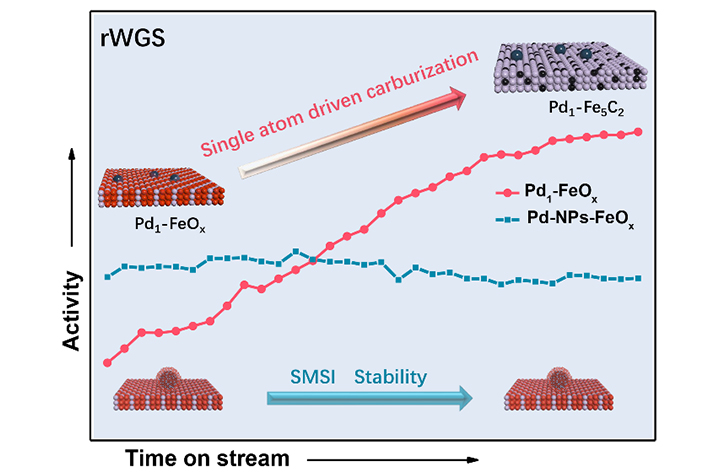 11 18, 2022Single-atom-driven Dynamic Carburization Boosts CO2 Conversion during Long-term ReactionResearchers revealed a novel mechanism of single-atom catalysts in real reactions.
11 18, 2022Single-atom-driven Dynamic Carburization Boosts CO2 Conversion during Long-term ReactionResearchers revealed a novel mechanism of single-atom catalysts in real reactions.
Single-atom catalysts (SACs) are a new type of heterogeneous catalysts due to their ultimate efficiency of metal atom use and unique activity/selectivity compared with nanoparticle catalysts.
Current studies in SACs focus on the specific activity and selectivity of the single active sites, the distinct reaction mechanisms in real reactions are still unclear.
Recently, a research group led by Prof. ZHANG Tao and Assoc. Prof. YANG Bing from the Dalian Institute of Chemical Physics (DICP) of the Chinese Academy of Sciences (CAS), in collaboration with Prof. ZHU Beien from Shanghai Institute of Applied Physics of CAS, revealed a novel mechanism of SACs in real reactions.
"Besides providing single active sites, the Pd SACs could also promote the dynamic carburization of FeOx surface over long-term reaction during CO2 conversion, leading to remarkably enhanced reverse water-gas shift activity and CO selectivity," said YANG.
This study was published in Chem on September 12.
Single-atom-driven dynamic carburization over Pd1-FeOx SACs (Image by YANG Bing)
The researchers found that Pd1- FeOx SACs promoted sustained carburization of FeOx surface over long-term reaction with increasing reverse water gas shift activity (from 17% to 28%) and CO selectivity (>98 %). By contrast, Pd-NPs-FeOx (~4nm Pd nanoparticles) possessed excellent stability during the entire time-on-stream test with CO2 conversion remaining at ~20%.
Moreover, they reported an unexpected role of Pd1 single atoms. The Pd single atoms not only provided single active sites by activating surface oxygen species at the initial stage, but also promoted dynamic carburization of FeOx surface to achieve the highly active Fe5C2 phase and diminish active barriers to 27.7 kJ/mol over long-term reaction, far beyond that of previously reported Fe-based catalysts. In comparison, carburization was inhibited on Pd nanoparticle catalyst by a rapid FeOx encapsulation during the initial reaction via strong metal-support interaction.
"This work improves the general understanding of the reaction mechanism of SACs," said YANG. "The role of single atoms is not only to provide single active sites but to promote the formation of the highly active phase of heterogenous catalysts during real reactions, and both roles should be considered in the rational design."
The above work was supported by the National Key R&D Program of China, the National Natural Science Foundation of China, the CAS Project for Young Scientists in Basic Research, and the Innovation Grant from DICP. (Text by DU Pengfei and YANG Bing) -
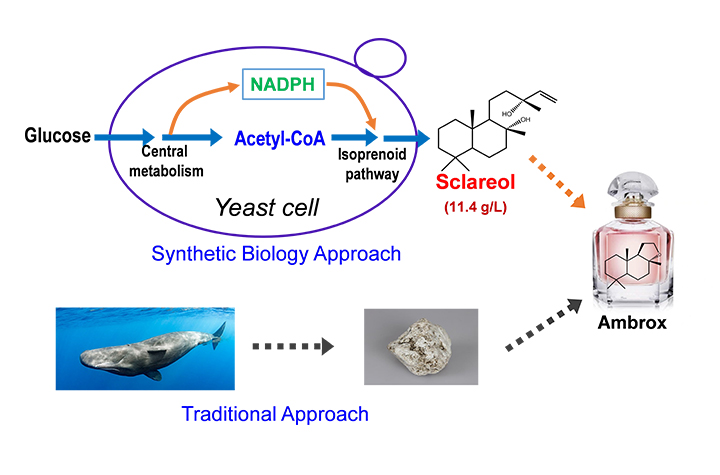 11 17, 2022Engineering Yeast Enables High-level Production of Diterpenoid SclareolProf. ZHOU Yongjin's group has established a synthetic biology approach for diterpenoid production. They systematically engineered the brewing yeast Saccharomyces cerevisiae to produce sclareol.Sclareol, a precursor for synthesis of fragrant chemical compound Ambrox, is traditionally extracted from the flowers and leaves of Salvia sclarea. However, it requires laborious and cost-intensive purification procedures due to the low concentration of sclareol in complex mixtures.Recently, a research group led by Prof. ZHOU Yongjin from the Dalian Institute of Chemical Physics (DICP) of the Chinese Academy of Sciences (CAS) has established a synthetic biology approach for diterpenoid production. They systematically engineered the brewing yeast Saccharomyces cerevisiae to produce sclareol.This study was published in Metabolic Engineering on Nov. 9.Engineering yeast for high-level production of diterpenoid sclareol (Image by CAO Xuan)The researchers systematically engineered brewing yeast Saccharomyces cerevisiae for overproduction of sclareol by engineering the isoprenoid biosynthetic pathways. This revired its central metabolism and enhanced supply of precursor and cofactor.For convenient manipulation, they developed a metabolic transforming strategy to transform a fatty-overproducing strain Y&Z036 toward sclareol overproduction at a modular manner, which facilitated the construction of versatile cell factories."Transcriptome and metabolic flux analysis showed that the global metabolic rewiring improved diterpenoid biosynthesis. Our strategy may improve the production of other acetyl-CoA-derived molecules," said Prof. ZHOU.This work was supported by the National Natural Science Foundation of China, and the Key project at central government level. (Text by CAO Xuan)
11 17, 2022Engineering Yeast Enables High-level Production of Diterpenoid SclareolProf. ZHOU Yongjin's group has established a synthetic biology approach for diterpenoid production. They systematically engineered the brewing yeast Saccharomyces cerevisiae to produce sclareol.Sclareol, a precursor for synthesis of fragrant chemical compound Ambrox, is traditionally extracted from the flowers and leaves of Salvia sclarea. However, it requires laborious and cost-intensive purification procedures due to the low concentration of sclareol in complex mixtures.Recently, a research group led by Prof. ZHOU Yongjin from the Dalian Institute of Chemical Physics (DICP) of the Chinese Academy of Sciences (CAS) has established a synthetic biology approach for diterpenoid production. They systematically engineered the brewing yeast Saccharomyces cerevisiae to produce sclareol.This study was published in Metabolic Engineering on Nov. 9.Engineering yeast for high-level production of diterpenoid sclareol (Image by CAO Xuan)The researchers systematically engineered brewing yeast Saccharomyces cerevisiae for overproduction of sclareol by engineering the isoprenoid biosynthetic pathways. This revired its central metabolism and enhanced supply of precursor and cofactor.For convenient manipulation, they developed a metabolic transforming strategy to transform a fatty-overproducing strain Y&Z036 toward sclareol overproduction at a modular manner, which facilitated the construction of versatile cell factories."Transcriptome and metabolic flux analysis showed that the global metabolic rewiring improved diterpenoid biosynthesis. Our strategy may improve the production of other acetyl-CoA-derived molecules," said Prof. ZHOU.This work was supported by the National Natural Science Foundation of China, and the Key project at central government level. (Text by CAO Xuan)